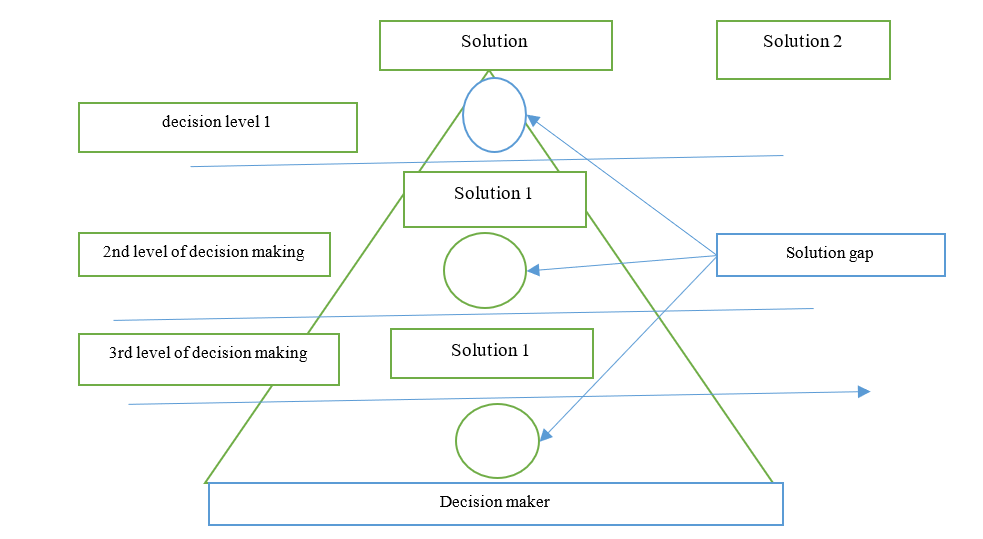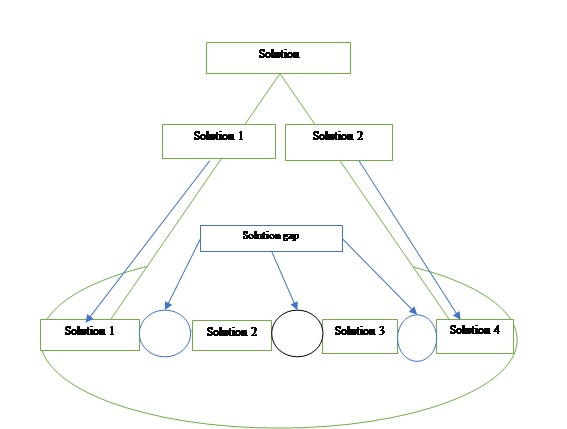Abstract
The paper deals with decision making theory and its peculiarities in economic systems. Attention is focused on horizontal and vertical gaps in decision making. The vertical gap in the decision is observed in public administration bodies, where decisions are not coordinated with the lower level. The activity of economic entities and government bodies is subject to this negative factor, which leads to failure to meet the set objectives. Public bodies are more confirmed by vertical gaps in their decisions, because higher bodies cannot accurately describe the situation on the ground. Horizontal gaps in decisions are a more complex economic category, where the problem arises from ignorance of the actions of other economic agents. The complexity of decision making in economic systems lies in the need for detailed elaboration, as well as in reducing the negative impact of the gap on economic agents. Solution gaps are always a topical issue in complex systems. Economic agents face destructive actions in their activities, in which there is no information or solution for use on the market. Unprocessed legislative acts have been adopted, and the mechanism of action is not prescribed for economic agents. The activity of an economic agent is affected by the gap in decision-making, which leads to a decrease in the efficiency of decision-making at all levels of the state and interaction of economic agents with each other.
Keywords: Economic agenttheory of decision makingsolution
Introduction
As the number of solutions increases, the gaps in the activity of the economic agent increase. More and more data, which is needed for making decisions, are missed for the task at hand. This problem can be identified immediately before the set goal is achieved.
Qualitative results can be achieved in the activity of the enterprise only due to the reduction of this adverse factor. Activity of the economic agent is always connected not only with strategy development, but also with aspiration to reach planned indicators.
Problem Statement
In decision-making theory, there has always been a pressing issue of the lack of information for the economic agent to make decisions. Management decisions in management mostly depend on the use of economic information to make decisions as well as to justify the results obtained due to lack of experience and other factors that do not have a negative impact on making informed decisions.
This problem is not only related to the lack of information but is also a natural process in which decisions need to be based on the available theories in this area.
Research Questions
What is the vertical solution gap in the economic system?
What is the horizontal solution gap in the economic system?
Describe the properties and differences in these approaches among themselves?
Purpose of the Study
The aim of the study is to identify and describe gaps in the solution in the economic system. Understanding of this issue allows economic agents to apply more rational solutions in the market.
Research Methods
Analysis of successful global experience in decision theory
The side effect associated with increasing or decreasing information increases the gap between the sequence of decisions taken by economic agents. Nevertheless, the problem of gaps has not been finally resolved.
The majority of decisions cannot be complete, i.e. transition from one decision to another must exist, and difficult to achieve completeness in management tasks is formed. The smoothness of task fulfilment is mostly not possible in practice, i.e. any task in decision-making is a few simple tasks, on the basis of which solutions to the whole problem are built.
In theory of decision-making it is possible to subdivide into segments: on the one hand, technical systems, on the other hand, social and economic, where processes take place in different ways.
In a technical system, decision-making has to be consistent and without gaps, as it cannot bridge the gap. In this case, the challenge is the continuum of actions that is inherent to the system ( Wu, 2016).
In social and economic systems, there is a problem associated with the specificity of economic agents who cannot make all decisions continuously because human thinking cannot solve all problems simultaneously. The problem consists of elementary actions, i.e. decisions are made on actual problems, and the connection between them and other unsolved problems is weak, i.e. there is still a lack of data and competence and as a result, this issue is not being worked out.
If we compare these systems, the decisions made in technical systems can be implemented in social and economic processes...
The solution gap is one of the complex problems of the modern apparatus of the theory of decision making, as all methods used in this area cannot explain the lack of transition between two consecutive solutions ( Akerkar & Sajja, 2009).
The general theory of acceptance is based on the stage of decomposition of one complex problem into small tasks to make it easier to solve the set goals. Loss of information as well as side effects lead to formation and distortion of data ( Shi, 2016).
What is the vertical solution gap in the economic system?
An economic agent is not always able to correctly assess and avoid these phenomena. In a national economy, the negative effects are more visible than in technical systems.
Vertical and horizontal gaps in the solution result not only in inefficiency, but also in the need for time resources to match the targets with the actual ones. These elements will be considered later in stages. Figure

Figure
When making vertical decisions, the question about gaps in the lower levels arises. Information flows directed downwards need to be formed more precisely, and requirements to eliminate this negative phenomenon are increasing.
Vertical gaps in decisions are often found in state administration of the centralized type, in which management depends on the center. Nevertheless, this problem is not exhausted only because of decentralization, as there are always national goals to be implemented.
What is the horizontal solution gap in the economic system?
The national strategy does not always take into account the peculiarities of the regions, leading to the problem of a wider emergence of solution gaps at the lower level.
Let us consider the horizontal solution gap in the economic system Figure

Figure
The problem lies in the complexity of coordination of all participants in the process. Breaking the problem into smaller parts contributes to the effectiveness of economic agents' activity in meeting the set tasks. For the most part, it is a question of forming a clear distinction between actors and powers to avoid this negative effect.
Horizontal gap in the solution of the problem is a fairly common problem of government agencies at a low level, which leads to the direct implementation of the set tasks on the ground.
Describe the characteristics and differences of these approaches among themselves
Thus, the decision making and the phenomenon of the gap are considered, this issue in the economic system allows achieving more efficient management. On the one hand, this issue affects the principles of management. It would seem that the issue should be removed from the monitoring function. The situation is getting worse, because thanks to management monitoring alone, it is not only impossible to eliminate the problem, but also to track the moments when gaps appear.
On the other hand, the business process is self-regulating, i.e. after starting a business these gaps are removed over time. To the difficulties encountered, it is possible to quickly find the right solutions for their arrangement in the enterprise.
The formation of complex strategies leads to an increase in the emergence of large masses of solution gaps in the organization.
When considering the two types of gaps in the economic system, it is possible to draw conclusions about the feasibility of a detailed study of the emergence and spread of solutions at various levels.
Findings
The paper deals with the gaps that arise in social and economic systems when making decisions in the activity of an economic agent in the market.
The vertical gap in decisions arises when powers are delegated to the depth or from the top level to the bottom. This issue is relevant in modern decision-making theory because it arises everywhere in complex systems.
The increase in the volume of data, as well as the growth of decision-making, leads to the complication of all types of tasks faced by the economic agent, thus increasing the gaps in the actions taken.
Conclusion
Introduction of the notions of vertical and horizontal approaches in the economic system allows to understand interaction of economic agents and elements among themselves in the management of the state.
Economic agents may not always have complete information, i.e. this situation arises quite constantly.
To make more rational decisions, the economic agent needs to grow a system in which the gap in decisions is minimized.
Steps to build such a system:
Identify which solution gaps arise in the economic system.
Identify vertical gaps solution
Determine a horizontal solution
Formulate recommendations to reduce these negative factors on the activities of economic agents.
In the economic system, all participants should reduce the impact of these factors on the activities of economic entities. Public services in the management of regional systems should ensure local problems on the part of the state apparatus.
Acknowledgments
We would like to thank the anonymous reviewer for the constructive comments to improve the manuscript.
References
- Akerkar, R., & Sajja, P. (2009). Knowledge-based systems. Jones & Bartlett Learning.
- Khalilov, A. E (2018a) Sovremennaya tekhnologicheskaya ekonomicheskaya kibernetika v upravlenii ekonomicheskoy sistemoy. [Modern technological economic cybernetics in the management of the economic system: a monograph]. The Shovel FOP. [in Rus.]
- Кhalilov, A. E. (2018b). Struktura prinyatiya sotsial'no-ekonomicheskikh resheniy v narodnom khozyaystve. [The structure of the adoption of socio-economic decisions in the national economy]. Modern science: actual problems of science and practice. Series: economics and law, 3, 80-84. [in Rus.]
- Кhalilov, A. E. (2017). Optimizatsiya upravlencheskikh resheniy po neskol'kim proyektam na rynke. [ Optimization of management decisions by several projects in the market]. Modern science: actual problems of science and practice. Series: Economics and Law, 3, 40-46. [in Rus.]
- Shi, F. (2016). Data decision-making to analyze the value of data. China Information Technology, 9, 68-70.
- Wu, J. C. (2016). Analysis of corporate decision-making, execution and control. Contemporary power culture, 8, 52-53.
Copyright information

This work is licensed under a Creative Commons Attribution-NonCommercial-NoDerivatives 4.0 International License.
About this article
Publication Date
21 October 2020
Article Doi
eBook ISBN
978-1-80296-089-1
Publisher
European Publisher
Volume
90
Print ISBN (optional)
-
Edition Number
1st Edition
Pages
1-1677
Subjects
Economics, social trends, sustainability, modern society, behavioural sciences, education
Cite this article as:
Khalilov, A. E. (2020). Solutions Gap In Socio-Economic Systems. In I. V. Kovalev, A. A. Voroshilova, G. Herwig, U. Umbetov, A. S. Budagov, & Y. Y. Bocharova (Eds.), Economic and Social Trends for Sustainability of Modern Society (ICEST 2020), vol 90. European Proceedings of Social and Behavioural Sciences (pp. 1070-1075). European Publisher. https://doi.org/10.15405/epsbs.2020.10.03.123

